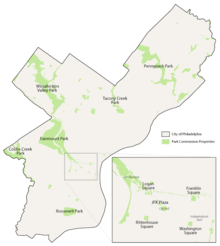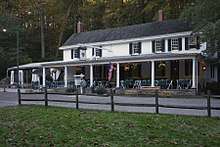Wissahickon Valley Park
.tiff.jpg)

Wissahickon Valley Park contains 2,042 acres (8.26 km2)[1] of parkland in Northwest Philadelphia, including the Wissahickon Creek from its confluence with the Schuylkill River to the northwestern boundary of the city with eastern Montgomery County. Visitors travel by foot, bicycle and horse along Forbidden Drive[2] where motor vehicles are not allowed.[3] Side trails off Forbidden Drive lead up into the wooded gorge above the creek[2] along a total of 50 mi (80 km) of trails.[3] Philadelphia Parks & Recreation manages the park as the second largest part of the city's parkland areas, after the slightly larger Fairmount Park.[3] The Wissahickon Valley was designated a National Natural Landmark in 1964, including 1,250 acres (5.1 km2) of the parkland.[4]
History
While logging and industrialization occurred in some parts of the valley in the late 18th and early 19th century, the gorge itself was known for its natural environment, inspiring religious mystics like Johannes Kelpius,[5] writers like Edgar Allan Poe, John Greenleaf Whittier, George Lippard, and William Cobbett; and artists like Thomas Moran, James Peale, William Trost Richards, and Currier and Ives.[6]
Landmarks

- Valley Green Inn, a tavern built in 1850[7][8]
- Wissahickon Hall, the first of numerous inns in the valley[9]
Houses
- Cedars House[10]
- Hermitage Mansion[11]
- Livezey House, a colonial era mill (aka Glen Fern)[12]
- Monastery House[13]
- RittenhouseTown
- Thomas Mansion[9][14]
.jpg)
Bridges
- Fingerspan Bridge
- Kitchen's Lane Bridge
- Thomas Mill Covered Bridge
- Walnut Lane Bridge
- Wissahickon Memorial Bridge (aka the Henry Avenue Bridge)
Other
- Cresheim Creek
- Devil's Pool
- The Indian and Toleration statues
- Mom Rinker's Rock
See also
References
- ↑ "The City of Philadelphia, Emerald Ash Borer Management Plan" (PDF). dcnr.state.pa.us. The City of Philadelphia. 2012. p. 2. Archived (PDF) from the original on December 19, 2016. Retrieved December 19, 2016.
The City contains approximately 6,781 acres of watershed parks including East/West Fairmount Parks (2052 ac.), Wissahickon Valley Park (2042 ac.), Pennypack Creek Park (1343 ac.), Cobbs Creek Park (851 ac.), Tacony Creek Park (304 ac.), and Poquessing Creek Park (189 ac.)
- 1 2 "Wissahickon Valley Park". Schuylkill River National & State Heritage Area. Retrieved 21 March 2016.
- 1 2 3 "Friends of the Wissahickon and Wissahickon Valley Park FAQ". Retrieved December 19, 2016.
- ↑ "National Natural Landmarks, Wissahickon Valley". Retrieved December 19, 2016.
- ↑ Lucy E. Carroll (1 October 2008). The Hymn Writers of Early Pennsylvania. Xulon Press. pp. 15–. ISBN 978-1-60647-520-1.
- ↑ Andrew Mark Herman (2004). Along the Wissahickon Creek. Arcadia Publishing. pp. 7–. ISBN 978-0-7385-3521-0.
- ↑ Valley Green Inn
- ↑ Anna Dubrovsky (25 August 2015). Moon Pennsylvania. Avalon Travel Publishing. pp. 146–. ISBN 978-1-61238-844-1.
- 1 2 "Wissahickon Valley Park Points of Interest" (archive). fairmountpark.org. Retrieved November 6, 2017.
- ↑ Cedars House
- ↑ Hermitage Mansion
- ↑ Livezey House
- ↑ Monastery House and stables
- ↑ Thomas Mansion
External links
- Friends of the Wissahickon
- Parks & Recreation department
- National National Landmark
- Visit Philly: The Wissahickon Gorge
Coordinates: 40°02′23″N 75°12′31″W / 40.039722°N 75.208547°W